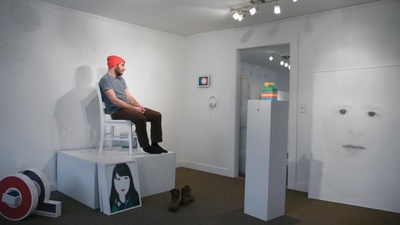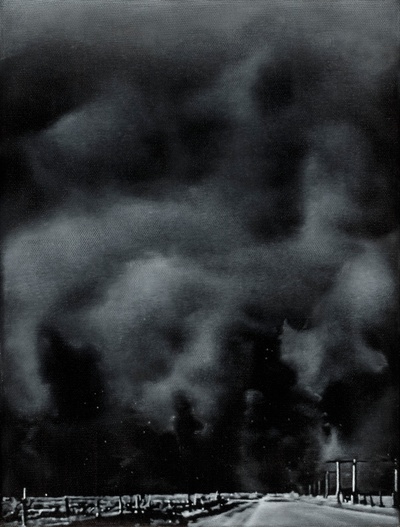Sam Trioli and Tim Donovan: All That Can Be Done

Tim Donovan’s presentation room at his studio (with model).
In writing this column and making the studio visits that inform the writing I am working out of artistic self-interest. My self-therapy consists of a desire to pull myself out of the studio, away from a minimalist/conceptualist approach to painting. I continue to paint from that grounding, yet I observe that the most interesting art being made at this time derives from an expanded platform; hence my columns seek to examine artists who have demonstrably expanded theirs. I look for the motivations and questions they distinctively address.
As an artist, one often needs to establish a rigor and an isolated studio practice in order to prove one’s depth, but at a certain time, developmentally and culturally, that rigor can prove resistant to generous conversation. In contrast, Sam Trioli and Tim Donovan are two artists who have developed generous and wide-ranging practices motivated by raw curiosity and a thirst for engagement. I have chosen to write about these two artists together, not because they form a collaborative or because their individual work is necessarily connected, but because they are two artists who have recently: (1) had important shows in Boston; (2) are active in New Hampshire (my own state); (3) attended New Hampshire Institute of Art (NHIA) in its formative stage; and (4) have established, together, a presence in New York with their gallery called Launch F18. As artists, they represent the full possibility of what enthusiasm can accomplish, and each carries this characteristic in markedly different ways.
Sam Trioli keeps a studio in Mount Vernon, NH. Sam is innately an artist and has been since grade school when he knew he was the best. He still carries that confidence and it has blended with a fully transparent strategic hunger for a place at the table. He was accepted at all of the best art schools yet chose NHIA with the sense that he could create his own world there—that he would have both support and independence. At NHIA he studied with the accomplished realist, James Aponovich, and met Tim Donovan. They began an ardent dialogue fueled by a few great teachers.
Tim Donovan came to art slowly. He has founded and run a farm-based brain-injury rehab center, in Peterborough, that has eventually involved his entire family. He was searching and curious and first found his way into art by assisting an artist from the nearby MacDowell Colony, Helène Aylon. Aylon is a conceptual ecofeminist artist who introduced Tim to a new range of artistic possibilities. Tim has responded with a sustained sense of wonder and generous amazement at both the possibilities of art and the odd souls that populate the art conversation. Even in the late ’90s, he’d volunteered with the Provincetown International Film Festival and gradually worked his way into that world, becoming close with John Waters. Sam and Tim are both propelled by possibility; Sam has it mapped out, while Tim just knows the ride is going to be interesting.

Sam Trioli, Untitled (Dust Bowl), 2012, oil on canvas, 12 x 9″.
After NHIA, Sam spent more and more time in New York City and eventually talked his way into working for an artist he admired, Damian Loeb. Sam had clearly identified his love of hyperrealism and the Mary Boone Gallery as his ideal interests. Additional assistantships followed with Adam Stennett, Ross Bleckner, Jeff Koons and, currently, David Deutsch. Sam had developed exceptional facility as a photo-realist, but he is simultaneously wary of being over defined by the wow factor associated with that skill. His recent show at Howard Yezerski Gallery (Brumaire) presented dark images painted from photographs of explosions. The dark palette and subject matter somehow were contradicted by a surprising feeling of lightness, perhaps made possible by the small and thin scale of the paintings and the masterful technical painting that was so highly refined and hidden. Sam is also engaged in several ongoing conceptual projects, including a notebook in which he keeps a deadpan recording of all his daily actions, with accompanying maps.
Tim’s spring show at Gallery Kayafas (Phantasmagoric), featured several large-scale portrait photographs of young faces reduced to minimal saturation so that eyes and lips predominate. These hauntingly beautiful images found a way to express human qualities with a confusing presence. It is hard to know, at first, what medium one is engrossed in—drawing, painting or photography. What does emerge is a vulnerability and humanity that gets under the skin. Inevitably, the larger story of Tim’s life and variety of vocational and artistic interests somehow come back to put so much more into these portraits than a face. Tim has also run a gallery in Peterborough for many years, Launch. It has grown to be a center for local experimentation and generous community conversation.

Tim Donovan. Installation image of photography solo exhibition
Phantasmagoric at Gallery Kayafas in Boston. April 6–May 12, 2012.
Launch F18 (F18 is the room number) began as a shared studio space in Tribeca that Sam and Tim had taken on in 2010. Originally the plan was to use the space to receive studio visits from potential gallerists, critics, and artists. At some point they realized it offered an opportunity to show the work of others, the first being a Slovakian artist that Tim had become interested in, Andrej Dubravsky. With this gallery, they have found that they could concentrate on openings, create events, and invite guests from their growing and impressive list of contacts, and then depend on critical and social response to build a reputation for the gallery. All this has happened. Sales are not a particular priority, instead, building a following and communicating a vision are the motivators. Of course, this is also the smartest way to actually build a gallery, and careers, that might have real currency down the road.
As artists, these two are taking on all that can be done and finding that sheer engagement—engagement without stultifying doubt—is enough to propel a vivid moment of being.
Craig Stockwell is an artist, writer, and contributor to Art New England. His Studio Visit column appears periodically in the magazine and online at artnewengland.com.
